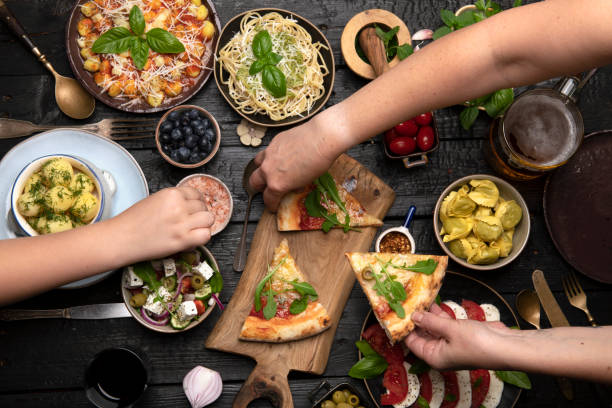Italian cuisine is celebrated worldwide for its rich, comforting, and diverse flavors. From pasta and pizza to exquisite wines and delectable desserts, Italian food is a journey for the senses.
1. A Culinary Mosaic of Regions
Italy is a land of diverse regions, each with its culinary traditions and specialties. The Italian culinary map can be divided into northern, central, southern, and insular regions, with each offering unique ingredients and dishes. For instance, the north is known for its creamy risottos, hearty polentas, and rich truffle dishes. Central Italy boasts classics like pasta all’amatriciana and the legendary Bistecca alla Fiorentina. In the south, you’ll find spicy and sun-kissed flavors, with dishes like pasta con le sarde and eggplant parmigiana. The islands of Sicily and Sardinia contribute their unique seafood and rustic, hearty cuisine.
2. The Allure of Pasta
Italian pasta comes in a multitude of shapes and sizes, each suited to specific sauces and preparations. From the ever-popular spaghetti, fettuccine, and penne to the more regional orecchiette, trofie, and pappardelle, pasta is a canvas for creativity in Italian cooking. It’s often served al dente, perfectly cooked to maintain a pleasant, slightly firm texture.
3. Iconic Sauces
Italian cuisine is famous for its sauces. Classics like marinara, Alfredo, carbonara, and pesto have become staples in kitchens worldwide. Marinara is a simple tomato-based sauce, while Alfredo offers a rich and creamy indulgence. Carbonara is a delectable mix of eggs, cheese, pancetta, and black pepper, and pesto combines fresh basil, pine nuts, Parmesan, garlic, and olive oil for a burst of flavor.
4. Pizza: Italy’s Gift to the World
The pizza, a worldwide favorite, originated in Italy. Neapolitan-style pizza, with its thin crust, fresh tomatoes, mozzarella, basil, and olive oil, is the foundation for modern pizza. You’ll find a range of toppings, from classic Margherita to creative combinations like prosciutto and arugula or gorgonzola and pear.
5. Irresistible Risotto
Risotto, a creamy rice dish, is a culinary masterpiece from northern Italy. Arborio or Carnaroli rice is cooked with broth and wine until it reaches a luxurious consistency. Variations include saffron-infused Milanese risotto and earthy mushroom risotto.
6. The Art of Antipasti
Italian meals often begin with antipasti, a delightful array of appetizers. Prosciutto, mozzarella, olives, marinated vegetables, and bruschetta are among the common choices. These light bites pave the way for the main course.
7. Olive Oil and Balsamic Vinegar
Italian cuisine relies on high-quality olive oil and balsamic vinegar. Extra-virgin olive oil is used in salads, sautés, and for dipping bread. Balsamic vinegar from Modena is renowned for its complexity and depth of flavor.
8. The Finest Cheeses
Italy produces an extensive range of cheeses, and they play a significant role in Italian cooking. Parmigiano-Reggiano, mozzarella, gorgonzola, and pecorino are just a few of the many Italian cheeses that grace the table.
9. Seafood Delights
Italy is blessed with a vast coastline, resulting in a bounty of seafood. Dishes like Cioppino, a seafood stew, and spaghetti alle vongole, pasta with clams, showcase the exquisite flavors of the sea.
10. Desserts: Dolce Delights
Italian desserts are irresistible. Tiramisu, a coffee-soaked layered treat, and panna cotta, a creamy custard, are internationally adored. Don’t forget the gelato, Italy’s velvety answer to ice cream.
11. Espresso and Cappuccino
Italian coffee is legendary. Espresso, a strong and concentrated brew, is enjoyed in small cups, often as a quick pick-me-up. Cappuccino, a blend of espresso and frothy milk, is a morning ritual for many Italians.
12. Wine Culture
Italy is one of the world’s leading wine producers. From the Chianti region of Tuscany to the sparkling Prosecco of the Veneto, Italian wines are diverse and esteemed. Wine is an integral part of Italian meals, and each region offers unique varietals.
13. Festive Food Traditions
Italians are passionate about their food traditions, with festivals and feasts held throughout the year. The Feast of the Seven Fishes, La Festa di San Giuseppe, and Carnevale are just a few examples. These celebrations often revolve around communal meals and signature dishes.
14. Coffee Culture
Coffee culture in Italy is not just about the brew; it’s a social ritual. Standing at a café counter for a quick espresso is common, while leisurely sipping a coffee at an outdoor table offers a chance to soak in the local atmosphere.
15. Culinary Traditions: From Farm to Table
Italian cooking emphasizes fresh, locally sourced ingredients. The farm-to-table movement is deeply ingrained in Italian culture. Regional markets and artisanal producers are cherished for their role in preserving culinary traditions.
16. Italian Hospitality
Italians are renowned for their warm hospitality, and food is an essential part of welcoming guests. A home-cooked Italian meal often includes an abundance of dishes to ensure everyone feels well-fed and cared for.
17. Tradition Meets Innovation
While Italy’s culinary traditions are steeped in history, modern Italian chefs are not afraid to experiment. This fusion of tradition and innovation is creating a vibrant and dynamic food scene.
18. The Slow Food Movement
The Slow Food movement, which originated in Italy, advocates for the preservation of local food cultures and traditions. It encourages consumers to savor meals, appreciate local ingredients, and support sustainable farming practices.
19. Food as Art
In Italy, food is seen as a form of art. Presentation matters, and chefs take great care in crafting visually appealing dishes that are as delightful to the eyes as they are to the palate.
20. Cultural Significance
Italian food is more than sustenance; it’s a way of life. It brings families and friends together, provides comfort and celebration, and is a testament to the cultural importance of food in Italy.

